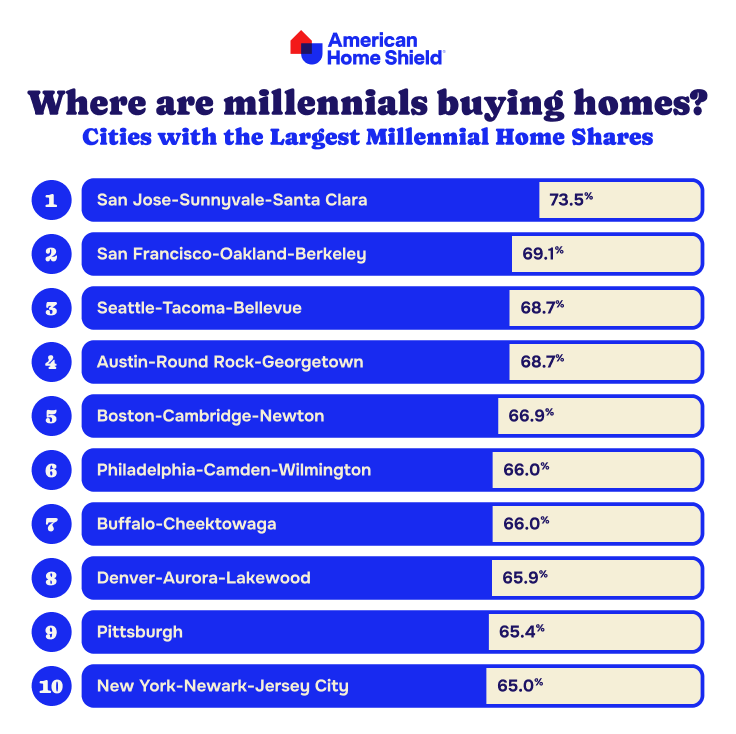Millennials are officially the largest group of homebuyers in the U.S. But they aren’t buying like their parents, or their parents’ parents. Though what percent of millennials own a home may be lower than that of Gen X and Boomers, they’re waiting longer, buying smarter, and facing challenges their predecessors couldn’t even fathom.
Today’s millennial buyers are savvy. They juggle student debt, sky-high rent, rising home prices, and a job market that can’t seem to make up its mind. But they’re also reshaping the very idea of homeownership— from co-buying with friends and family to snapping up multi-generational homes. It’s time to break down the relationship between millennials and housing to understand the current millennial homeownership landscape.
Financial barriers millennials face

The road for millennials and homeownership isn’t paved with gold. Honestly, it’s more like navigating a minefield of debt, high costs, and economic uncertainty.
Student loan debt
With the average millennial carrying a balance of $40,438 in student loan debt (6.99% higher than the national average), it’s no surprise they’re feeling financially strapped. It’s a huge chunk of their paycheck going toward loan payments, which delays savings for a down payment.
Rising mortgage rates
Millennials aren’t excluded from feeling the sting of higher interest rates. In 2021, rates were hovering around 3%. By late 2023, they topped 7%. That’s an extra $800+ a month for the average buyer on a median-priced home. It's a major budget-buster, and millennials know it.
Housing affordability
The housing affordability index has dropped below 100 in some areas, meaning median-income families can’t afford median-priced homes. Millennial buyers are feeling this more acutely as home prices climb, especially in places like California (hello, $869K median). Even if they want to buy, the homes they can afford are getting smaller and farther out.
Limited inventory
The housing supply isn’t keeping pace with demand. Boomers aren’t downsizing, so starter homes are in short supply. In fact, millennials are now the largest share of first-time homebuyers, but they’re buying later than previous generations. The average first-time buyer is 38 years old, up more than three years from the year before. It’s a trend that has led to an interesting shift in how many millennials own a home.
How millennials are adapting

With these hurdles, millennials have had to get creative with their approach to homeownership. These are some of the most popular solutions to help overcome these financial and logistical barriers and make millennial homeownership work.
Creative financing
Millennials are tapping into alternative financing options, from co-borrowing with friends or family to FHA loans, which offer lower down payments. This is a generation of side hustlers who might pick up a second job or start a business to make their down payment.
Multi-generational living
With housing costs eating up a large portion of their paychecks, millennials are increasingly turning to multi-gen homes. About 17% of homebuyers in 2024 purchased homes with multiple generations in mind. Whether it’s living with parents to save money or buying a larger house to accommodate relatives, sharing the space (and the expenses) is on the rise.
Compromising on size
So much for insisting on luxurious dream homes. These days, millennials are prioritizing value over size. They’re not afraid of a fixer-upper, and many are happy with homes that are smaller and more affordable. The phrase “cozy” is more popular than ever in real estate listings, indicating that millennials aren’t looking for mansions, they’re looking for something functional that feels like home.
Moving to more affordable markets
Many millennials are packing up their bags and heading to smaller metros and suburbs where homes are more affordable, and the cost of living is lower. Think Trenton, NJ; Ann Arbor, MI; or Syracuse, NY, where millennial buyers dominate the market. These places offer more bang for their buck, and millennials are finding it easier to live comfortably and still have some room to grow.

Source: constructioncoverage.com/research/cities-with-the-most-millennial-homebuyers
Millennials want flexible spaces and tech-savvy homes

Now that we understand the challenges millennials face, it’s time to answer a new question: what are millennials actually looking for in a home? Here are a few features:
Flexibility
The rise of remote work has made millennials crave homes with flexible spaces that can easily transition from office to guest room or from gym to study. Millennials are less about the cavernous open floor plans and more about creating a home that works for their life.
Smart homes are a must
Energy efficiency is at the top of the list— thanks to rising utility costs, they want homes that save them money. Whether it’s smart thermostats, energy-efficient appliances, or solar panels, millennials are willing to spend on tech that will pay off long term.
Sustainability
Millennial buyers are drawn to homes that are eco-friendly and designed for sustainability. Whether it’s a green roof or eco-friendly flooring, these buyers are increasingly looking for homes that align with their values.
Community matters
Millennials aren’t merely buying houses— they’re buying into communities. They want homes in walkable neighborhoods with access to parks, coffee shops, and places where they can interact with neighbors.
Advice for millennial homebuyers

Alright, millennials, listen up! Here’s your playbook for navigating this crazy homebuying journey.
Start with a budget and stick to it
Saving for a down payment is tough, and there’s no magic formula to making that budget stretch further than it can. Start by being realistic about what you can afford. Use mortgage calculators to estimate what your payments will look like at different price points. Factor in property taxes, home insurance, and even prospective home maintenance costs.
Partner with a knowledgeable real estate agent
It’s easy to get overwhelmed by options. Your real estate agent is your secret weapon— they can help you narrow down areas that fit your budget, needs, and long-term goals. They’ll also be a huge asset when it comes to negotiating terms and ensuring you’re not missing any hidden costs or red flags. So don’t go it alone.
Consider locations outside traditional hot spots
Sure, San Francisco is cool, but so are Madison, WI, and Provo, UT. Housing prices are lower, and the communities are vibrant. Think beyond the trendy, big cities and explore smaller metros or up-and-coming neighborhoods that are growing in popularity but still offer that affordable charm you’re after.
Save smart— look into creative financing
You don’t need to be a financial wizard to know that creative financing is your friend. Look into programs like FHA loans for first-time buyers, or even get creative with co-buying and try buying with a friend, a sibling, or even a parent. Don’t forget about down payment assistance programs— they’re out there, but you need to do the research to find them!
Embrace the fixer-upper mentality
Honestly, almost no one is buying their dream home on the first go. If you’re willing to roll up your sleeves, fixer-uppers can be a great option. You might have to invest time and effort, but in the end, you’ll build equity and customize your space to fit your needs. Just make sure to budget for repairs upfront (and check for any major issues like leaky roofs or foundation problems first!).






